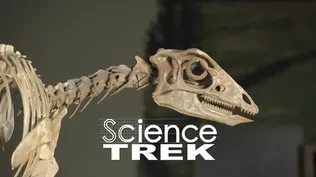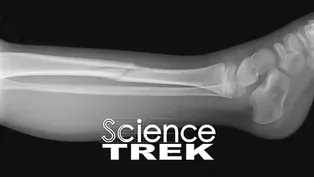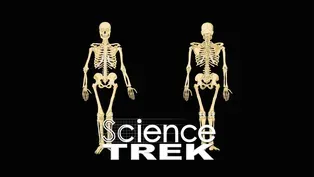
Skeletons: Just How Do They Know It’s A Dinosaur?
Special | 6m 12sVideo has Closed Captions
Paleontologists study skeletons to learn about ancient species.
Doctors can tell a lot about our health by looking at our bones. Paleontologists look at bones too. You’d be amazed what they can learn even millions of years after the creature died…. all from a skeleton.
Problems with Closed Captions? Closed Captioning Feedback
Problems with Closed Captions? Closed Captioning Feedback
Science Trek is a local public television program presented by IdahoPTV
Major Funding by the Laura Moore Cunningham Foundation and the Idaho National Laboratory. Additional Funding by Sparklight, the Friends of Idaho Public Television and the Corporation for Public Broadcasting.

Skeletons: Just How Do They Know It’s A Dinosaur?
Special | 6m 12sVideo has Closed Captions
Doctors can tell a lot about our health by looking at our bones. Paleontologists look at bones too. You’d be amazed what they can learn even millions of years after the creature died…. all from a skeleton.
Problems with Closed Captions? Closed Captioning Feedback
How to Watch Science Trek
Science Trek is available to stream on pbs.org and the free PBS App, available on iPhone, Apple TV, Android TV, Android smartphones, Amazon Fire TV, Amazon Fire Tablet, Roku, Samsung Smart TV, and Vizio.

Science Trek
Science Trek is a place where parents, kids, and educators can watch short, educational videos on a variety of science topics. Every Monday Science Trek releases a new video that introduces children to math, science, technology, engineering, and math (STEM) career potentials in a fun, informative way.Part of These Collections

Ages Past
Science helps explain what happened long ago. Find out what took place in ages past.
View Collection
Human Body
How does your body work? Find out more about the systems that combine to make up you.
View CollectionProviding Support for PBS.org
Learn Moreabout PBS online sponsorshipJoan Cartan-Hansen, Host: Doctors can tell a lot about our health by looking at our bones.
Paleontologists look at bones too.
And you'd be amazed what they can learn even millions of years after the creature died.... All from a skeleton.
[MUSIC] Cartan-Hansen: Humans aren't the only one that have skeletons.
All verbrate animals: Fish, reptiles, birds and mammals have internal skeletons and they all share basic characteristics...even if they lived millions of years ago.
Dr. Brandon Peecook, Idaho Museum of Natural History: The great thing about skeletons is, is that all skeletons come from the same common ancestor.
So, you have the arm bone, just one and then two right here, and then your hand.
An elephant has the exact same structure.
And so does T-Rex.
And so we can figure out based on looking at the anatomy, so the shape and structure of these bones, exactly how they fit together.
So, if I find an, arm bone of a dinosaur, no one's ever found before, even if I don't know what kind of dinosaur it is, I still know it's this arm bone, because that is a shape and has structure on it to attach to the shoulder, to attach to the rest of the arm.
That I'm always going to know that it's this bone, even if I don't know what animal that comes from.
Cartan-Hansen: Understanding what bones look like and how they fit together is the science of anatomy.
Paleontologists need to understand anatomy because they rarely find a whole skeleton.
Peecook: Usually we find just bits and pieces.
So, for example, this animal, this is a bison.
A bison like maybe you've seen before but of course this one has a much bigger horns.
It's a different species.
It's still called bison, but it's called Bison latifrons.
And so, I brought this bone up here to show you, so this is the same upper arm bone, same side.
And this is from a bison.
We know this is part of the arm because every bone has so much information in it.
This smooth area here is for connection with the shoulder.
This deep groove right here is for connection with the elbow.
So we can go like this.
And you can see in terms of this arm bone, the shape is really similar.
There's really not a lot of difference.
This is a bigger animal.
So maybe these ridges are larger because it has bigger muscles that have to attach onto the bone 'cause it's a bigger animal.
But I hope you can see that the shape anyway, of this bison bone from today and this fossil of an extinct bison they are almost totally the same.
Ones just a little bigger than the other one.
Cartan-Hansen: While skeletons are consistent in their structure, an individual bone, like a skull, can tell you a lot about how the creature once lived.
Peecook: If it's an animal that has teeth, you can look at its teeth, see if it has plant eating teeth or meat eating teeth.
So, most people sort of understand right away, really big, sharp, pointy teeth, especially long ones up in the front.
That's probably a meat eater.
But teeth can be very specialized.
Plant eaters have all kinds of different flat teeth and teeth with bridges and grooves.
Then there's animals, you know, like a rattlesnake say that has big fangs.
Those are also teeth, but they're not just fangs.
They have a little hole in them.
They're not just sharp, pointy teeth.
They have a hole in them so their venom can come through the tooth and into their prey.
And so, if you find an animal that has a skull that has teeth with a venom hole in a fang that tells you so much about this animal.
Cartan-Hansen: Paleontologists look where the eyes and ears were located.
That can tell them if the skull belonged to a predator or a prey animal.
They look at how long the face was or how big the brain would have been.
Each species has unique characteristics in its skull that scientists use to learn about how it moved, where it lived even how it attracted a mate.
Peecook: So, if you look around the natural world today, there's lots of animals with sharp pointy things on their heads.
And almost always, those sharp pointy things on animals' heads are being used to either fight one another, For the most part, boys fighting each other over girls, usually.
And we can make an inference.
We can say, okay so, if there's all these dinosaurs that also have all these sharp pointed things on their head, maybe they're using it to fight each other as well.
Cartan-Hansen: And understanding how the natural world works today gives us an insight into how it may have worked millions of years ago.
Peecook: So, this is an animal called Oryctodromeus.
And as of right now, it's the only dinosaur that we know of from Idaho.
And so you look at the skeleton of an animal like this, and you can immediately tell a bunch of things about how it lived its life, even though no one's ever seen one alive before.
So, you can see it's got big, long, strong back legs and pretty small arms.
It's a two legged animal it's walking around on legs and feet like you.
It also has these very tiny teeth that have little bumps on them that are perfect for eating plants.
There's animals today that have teeth like this.
And it has a little beak in the front, even that has no teeth at all, which is perfect for nipping off little plants.
And so, these pieces of its skeleton tell us a lot about how it lived its life, even though it's just the bones.
Cartan-Hansen: Though he now has a passion for studying bones and skeletons, Peecook says it was the chance to study nature that caught his imagination when he was kid.
Peecook: And I remember being in middle school and I kind of realized that fossils and ancient life that I think are so interesting and my backyard and flowers and butterflies and all that, all of biology is connected and the earth has this big, deep history.
And eventually I found myself following the path to become a person who goes out and digs up fossils all the time.
And takes care of them, keeps them in a museum so other people can study them or just learn from them or enjoy them.
I didn't have a moment when I was a little kid and say, I want to be a paleontologist.
I let experience sort of like take me through, um, that journey.
And I think everybody should do that if you have the chance, because it really helps you find what you're most passionate about.
Cartan-Hansen: If you want to learn more about skeletons, check out the science trek website.
You'll find it at science trek dot org.
[MUSIC] ANNOUNCER: Presentation of Science Trek on Idaho Public Television is made possible through the generous support of the Laura Moore Cunningham Foundation, committed to fulfilling the Moore and Bettis family legacy of building the great state of Idaho.
By the Idaho National Laboratory, mentoring talent and finding solutions for energy and security challenges, by The Friends of Idaho Public Television and the Corporation for Public Broadcasting.
Skeletons: All Bones Are Not the Same
Video has Closed Captions
You have two types of bones in your skeletal system. (1m 4s)
Skeletons: You’ll Find It Humerus
Video has Closed Captions
Over half the bones in your body are in two places. Can you guess where? (1m 4s)
Providing Support for PBS.org
Learn Moreabout PBS online sponsorshipSupport for PBS provided by:
Science Trek is a local public television program presented by IdahoPTV
Major Funding by the Laura Moore Cunningham Foundation and the Idaho National Laboratory. Additional Funding by Sparklight, the Friends of Idaho Public Television and the Corporation for Public Broadcasting.













